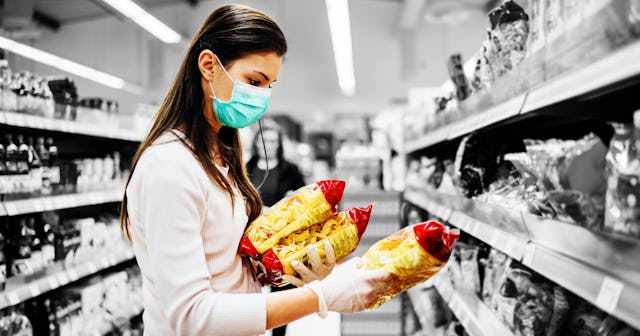It’s Time To Be Extra Cautious When It Comes To Grocery Shopping

Most of last summer, my wife and I would go shopping on Saturdays. We left the kids at home with our oldest in charge. We went to the grocery store, Costco, Target, the works, to get everything we needed for our family of five. We wore masks, and socially distanced. We washed our hands before and after each store, and we tried to keep our trips short, hopeful to limit our chances of getting COVID-19. This really was our only outing each week, and we assumed we were doing our part to stop the spread of the virus by only leaving the house weekly, and only doing the essentials to feed our family.
But in late October, my wife went into the hospital for septic shock, and once she came home, suddenly, she was at high risk for COVID-19 complications. So our grocery shopping trips turned into curbside pickup trips, or simply having the groceries delivered. And according to what experts are discussing about the new COVID-19 variant, anyone who has that option should be doing the same if at all possible.
Dr. Tom Frieden, the former director of the Centers for Disease Control and Prevention, had this to say on Twitter about visiting the grocery store: “Minimize time spent indoors around others. Shopping for five minutes in the grocery store is a lot better — six times better — than shopping for 30 minutes. Curbside pickup and grocery delivery if feasible/accessible.” And naturally, so much of his above recommendation has to do with the COVID-19 B.1.1.7 variant that was originally identified in the UK, but has now been found in 50 countries.
Now the issue with the variant isn’t that it’s more deadly. According to a recent article in VOX, there is no evidence to show that if you get the variant you are at greater risk of death. The issue is that it’s more contagious. Harvard epidemiologist Marc Lipsitch told VOX that it’s at least 50% more contagious. “In less than two weeks, you get twice the number of cases,” Lipsitch said. “And in a month or so, you have four, five times as many cases. But that’s very approximate.”
So the issue with hanging out in the grocery store with the new COVID-19 variant in the air is that you are more likely to contract the virus. And from speaking with family and friends, it sounds like the one place most people are still going is the grocery store, turning the weekly shopping trips into potential hotspots for the virus.
Take Southern California, for example. According to NBC4 in Los Angeles, “146 outbreaks were recorded last month alone at supermarkets in the southern part of LA County and in Orange County.” This is according to data they pulled from the United Food and Commercial Workers Local 324. It is unknown whether these outbreaks contained the new COVID-19 variant — but if this is what the “original” version of COVID-19 is doing at grocery stores, I can only imagine the damage a version of the virus that is 50% more contagious could do.
Guido Mieth/Getty
The real issue here is getting a lid on the virus before it can mutate further. According to a recent article in Science Magazine, the B.1.1.7 variant is not resistant to the COVID-19 vaccine yet. Volcanologist Philip Krause, who chairs a WHO working group on COVID-19 vaccines, gave this grim warning: “The not-so-good news is that the rapid evolution of these variants suggests that if it is possible for the virus to evolve into a vaccine-resistant phenotype, this may happen sooner than we like.” The concern is that the more bodies the virus infects, the more opportunities it has to duplicate, and during those duplications, the virus has the opportunity to mutate. This is how we ended up with the B.1.1.7 variant in the first place.
Naturally, this is not good news for shopping families, or grocery store employees. Going back to NBC4 in Los Angeles, Marisela Gonzalez, who works in produce at Albertsons in Tustin, said of her current working conditions, “Every time I go to work, I get scared about the risk.”
Much of this is preventable. Most grocery stores are doing curbside pickup. My wife and I have been using it for months now, and it’s pretty easy, and most grocery stores will do it without additional cost; they simply ask that you at least spend $35 or more. There are also many stores that will deliver groceries to your home. If neither of those options are available for you, you should heed the advice of Dr. Frieden, and try to make your shopping trips as speedy as possible. Go in with a pre-planned list, social distance, and wear a well-fitted, high-quality mask.
The overall goal here is to limit the number of people in grocery stores, and using these services will not only benefit shoppers, but also grocery store employees, by reducing exposure. And in so many ways, it’s quicker and easier. My wife and I were hesitant to do curbside pickup because of the dreaded substitutions, but now that we’ve gotten used to it, we’ve actually cut our shopping time in half each Saturday. That’s a huge plus on top of limiting our exposure to COVID-19.
I know, this is another change on top of a year of changes — but if doing something as simple as curbside pickup can save lives, it’s totally worth it.
This article was originally published on